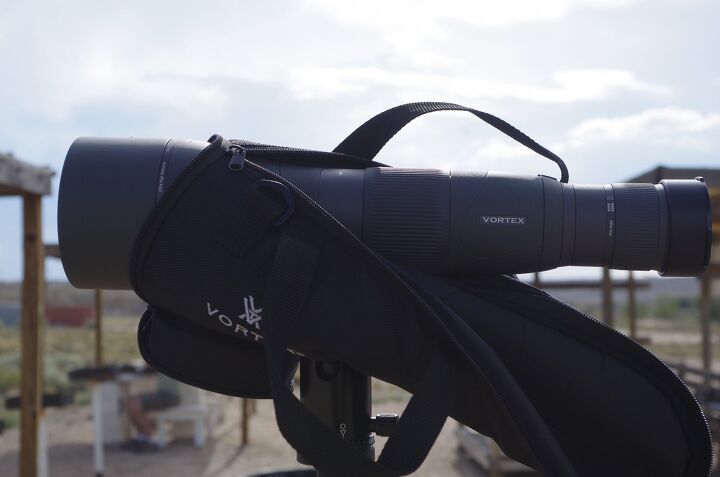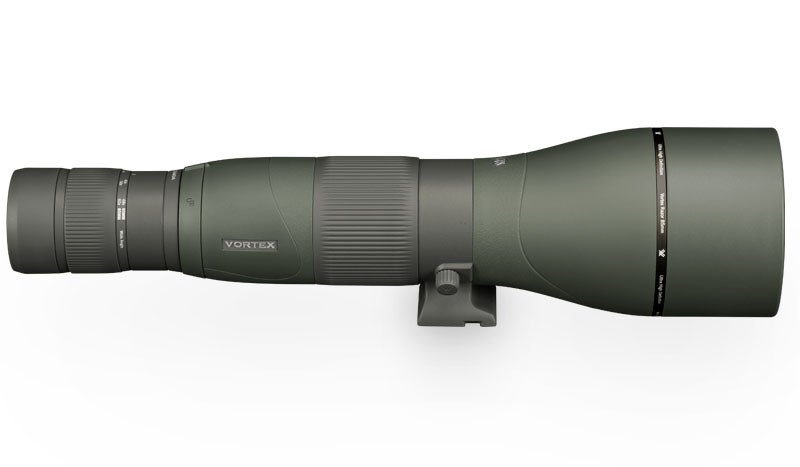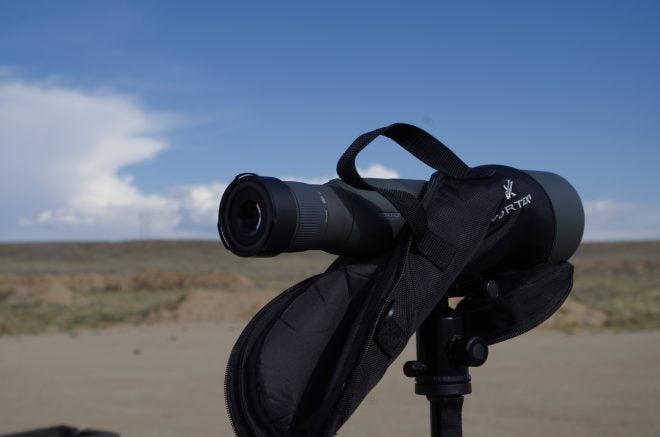Background
Apparently I am not the only creature in my house with the capability of failure testing gear. I had just purchased a new tripod for mounting my super “elite” Konus Spotting Scope. Okay, so maybe not elite, but we did successfully use it to spot impacts at 1200 yards at the Precision Long Range class I recently took. The problem I had was that the “elite” tripod that came with it was as sturdy as wet tissue. Anyhow, I bought a ZOMEI (not exactly a Manfrotto, I know), and set my scope up on it, and was peeping out from my living room window (I know, not creepy at all right?). I left it alone for about thirty-two and a half seconds and one of our annoying cats, decided to use it as a perch. And knocked the whole thing over. Which left me with a decent tripod and a large green maraca (also known as a spotting scope with busted internals that makes a great rattling sound).
So I did what any astute writer of a firearm blog should do, and contacted my editor to see if we had any reviews coming up for spotting scopes. I knew I was going to buy a new one, but wasn’t sure which one to go with. I had pretty much talked myself into a Leupold Mark 4 (to match my rifle scope), but Phil suggested I take a look at Vortex. My previous experience with Vortex was the Strike Eagle scope that was sent along with a Black Dawn rifle I did a review on a few months ago (and I found it way too busy for my liking–I didn’t *really* hate it, and did I mention I was a Leupold snoot?).
Anyway, Phil got in contact with a rep from Vortex and was told that their new Razor HD was about to release and they would be willing to send me out the newest (as in not even yet released to public, and “shhhhhh, don’t tell anyone”) to play with. I agreed, and not two days later I had a spotting scope which has definitely made me see Vortex differently. I still love you Leupold, but you are now going to have a new sister wife that goes to the range with us…
Construction
There are three components to the construction: the optics, the body, and some features for convenience.

It really does look like a mini telescope–I may try and see if I can capture some pics of the moon with it.
The optical features include high density, extra-low dispersion glass, a triplet apochromatic lens (which has better “correction of chromatic and spherical aberration than the much more common achromat lenses”–try and say that three times fast), a number of proprietary coatings to support greater light transmission along with anti-reflective coatings, and multilayer prism coatings (to also support color-accurate images). The outer surface of the lens is coated with their “ArmorTek” coating which is an ultra-hard, scratch-resistant material protects exterior lenses from scratches, oil and dirt.

It is nice and compact and the sunshade really provides good protection over the objective.
The body construction involves an entirely straight body that is water, fog and shockproof. The body is sealed with o-rings to prevent moisture, dust and debris from penetrating the tube which was purged with Argon gas (which should prevent fogging over a wide range of temperatures). The body itself is a die-cast magnesium alloy with strategically-placed rubber armoring which protects the internals and provides superior shock protection.
There are a number of features that make using the Razor HD a little easier as well as provide some additional protection. It has an adjustable eyecup that allows comfortable viewing with or without eyeglasses. It possesses a dual focus for both fast and fine adjustments. The main objective has a built in sunshade to reduce glare and to also protect from rain, etc.
All of this is backed by their VIP warranty. Basically a 100% transferable, anything goes warranty.
Technical Specifications
- Magnification: 27-60x
- Objective Lens Diameter: 85 mm
- Linear Field of View: 117-68 feet/1000 yards
- Angular Field of View: 2.2-1.3 degrees
- Close Focus: 16.4 feet
- Eye Relief: 17-16.7 mm
- Length: 16.2 inches
- Weight: 65.6 ounces
Observations
One of the immediate distinctive things to notice is that the scope is straight. Like a mini telescope. I wanted a straight scope (opposed to angled) because I like the ease of target acquisition, and honestly don’t like craning my neck forward. I realize that it means having the scope mounted higher (which can decrease stability in wind a little), but having the ability to stage the scope for use while standing in a comfortable position was something I was looking for. Most “straight” spotting scopes have an offset design (with the eyepiece being above the main body) making them a little more compact. This spotting scope was a little longer, but honestly it was still really compact. It actually fits very nicely (vertically next to my tripod) in the main compartment of an ALICE ruck (which I have dedicated to the storage and transport of my precision gear).
Focusing the scope was really nice. The middle of the body was the focusing adjustment. Rather than some little knob, the focuser was around the entire body, and operated super smoothly, allowing for very fine and precise adjustment.

The ridged rubber ring in the middle is the focusing ring. The eye piece is removable and swappable (though the wide angle that it comes with is a really solid starting component).
But really the most important part of the scope is the optical clarity. The best I can impart is that I was very impressed. Very. The clarity was very sharp and crisp. It definitely blew away the Konus I previously used… 🙂 I found it very easy to see trace through the Razor HD (when the conditions favored it). In fact, my wife, who had exactly zero experience was able to see trace. In conjunction with an adapter from PhoneSkope, I was able to video capture trace during a couple of shots taken from my Remington 700 (.308 Win) at 780 yards with a roughly 10 mph full value right to left wind. I added masking and a line to help see the trace; I thought the commentary was funny.
I was also able to capture mirage (which I did on a street as it was a little easier to stage). This was taken at about 650 yards (I added masking to help see the area with mirage):
Still photos through the optics (on a web page) just don’t do this scope justice (the full RAW photos are decent, though). I captured a few examples but none of them could demonstrate the actual clarity.
The prior version of the scope had the ability to switch out the eyepiece to alternate versions, and this version has the same feature (though right now there are not any new ones available). The version that I was most interested in was a milliradian reticle. What makes this particularly sexy is that you can change the characteristics of the scope without having to buy a whole new scope. For instance, the Leupold Mark 4 has a variant with a milliradian reticle, and that comes at a steep price of $3200. With the Vortex Razor HD, for around $300 (I’m guessing on price; based on the prior version), you can add a different eyepiece to the same base.
The padded case for the scope is also a nice touch. You can fully leave the scope inside it, allowing for attachment to a tripod without exposing the eyepiece or objective. The case also has conveniently placed velcro to allow the zippered covers to stay out of the way.
One other important consideration is that Vortex offers their VIP warranty. Meaning if an idiot cat jumps on your scope (or an idiot cat owner leaves a tripod with scope set up in a cat zone) they will replace/repair it. That is just awesome no matter how you look at it, and means they stand behind their quality and construction 100%. (I don’t plan to test this “feature” but it is nice to know they have it).
The Razor HD does come at a hefty price tag, sitting just under $2000 MSRP. But that is definitely priced in line with other quality optics in a similar feature set. And especially considering the ability to swap out eye pieces (fingers crossed that they will be bringing a milliradian reticle to market), it is a *really* good deal.
If the 85mm objective is too much for you they offer a 65mm and 50mm variant (with reduced magnification and price). The 50mm version (in straight scope) is offset, not inline as the 65mm and 85mm versions are (which also apparently can share eyepieces).
Conclusion
Being the first “high-end” spotting scope I have used (aside from the obligatory ooohing and ahhhhing at SHOT Show) and I am definitely impressed. The visual clarity was excellent and I did not see any marked chromatic aberration. Having been a Leupold snoot (as that is what my tribe uses), I wasn’t sure what to expect with the Vortex and I was very pleasantly surprised, enough so that I will be adding the Vortex Razor HD to my kit (over a Mark 4).
The thing I am definitely learning about precision shooting is that optics are definitely important, and skimping on quality, well, you get what you pay for, in both terms of construction and quality. Given that the previous version of the Razor HD was used at the “King of 2 Mile” challenge (by the winning team) I would say that this spotter is a solid contender, and will likely outstrip the needs of most shooters (author currently included… :)).
I also want to give a shout out and special thanks to PhoneSkope for rapidly getting me adapters for a scope that wasn’t even released. If you are looking for a way to record pictures or video from your optics I’m pretty sure they have what you need. I’ll try and get up a lightning review and showcase their adapters.
Finally, Vortex is currently assessing whether or not they will be providing an accessory eye piece that will include a reticle. The previous version did not enjoy wide adoption, which surprised me. I don’t know why you wouldn’t want a spotter with a reticle (especially one paired to your rifle optics). If this is something that is of interest to you, comment here or contact Vortex at: info@vortexoptics.com.
You can find out more information about the scope at: http://www.vortexoptics.com/product/vortex-razor-hd-27-60×85-straight-spotting-scope
 Your Privacy Choices
Your Privacy Choices
